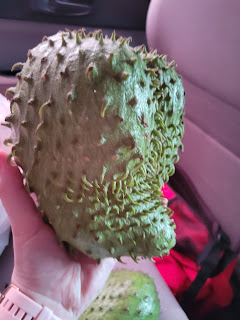Food and Grocery Shopping in Haiti
When I first moved to Haiti, my body was shocked by my new diet — but that's not a bad thing. I went from enjoying a steady stream of comfort foods to consuming a diet that consists mostly of organic, locally grown foods. What exactly are the common foods in Haiti, you might ask?
The Local Produce
One of the best things about Haiti is the delightful variety of fruits that are available. There are lots of familiar staples, such as bananas, cherries, mangoes, pineapples, and more. There are also some fruits that aren't so common in the U.S. For example, there is kachiman, a sweet fruit with a green exterior and white interior that tastes kind of like candy. Corossol, also known as soursop, is also all over the place here — it makes some pretty delicious juice. Then there is bilimbi, starfruit, sour oranges, and more. Mango trees are all over the place, and our friends often bring is tamarind, a kind of sour fruit that has tons of health benefits. Plantains are also really common. Breadfruit is another tasty one — it's particularly delicious when it is deep friend (but what isn't?).One fruit that you won't find a lot of around these parts is apples. You can purchase them at the local grocery store, but only if you are prepared to spend an arm and a leg.
When it comes to veggies, we have a rich variety of produce available to us. Spinach, lettuce, tomatoes, cabbage, celery and carrots are all pretty easy to come by. Starchy veggies like yams, potatoes, white sweet potatoes, corn, and more are also available. Before I came to Haiti, I had never tried white sweet potatoes before. I can't say I'm a fan of them, but they taste pretty good when they're blended with milk and sugar.
Protein and Dairy
There isn't a ton of dairy consumption in Haiti, but I have a strong liking for high-fat dairy products (which, I might add as a side note, tend to be more nutritious than their low-fat counterparts). We can buy butter at the local market, but fresh milk is conspicuously lacking. In fact, most people here consume canned milk, which is not all that yummy. Fortunately, we have a delightful neighbor who knows someone with a cow. She brings us super-fresh milk every few days. We boil it to kill any critters that might be lurking in it, and then we enjoy its deliciousness.
A bit further on the milk. In Haitian culture, it is common to add salt during the boiling process. I'm not a fan of the taste of that. A lot of families also enjoy adding sugar to their milk. I prefer it plain, perhaps boiled with some cinnamon for a touch of extra flavor. Also, since the milk isn't commercially processed, the fatty part tends to separate out during boiling, which means we sometimes get chunks of it while we are drinking. It's not a bad thing, but it took some getting used to.
As far as protein goes, we usually eat chicken. For a while, my sister-in-law was having to kill, pluck, and process the poor birds before they were edible. Fortunately, she found another seller who does that part of the work for us. We do our best not to let any edible part of the chicken go to waste, so we occasionally eat chicken liver as well as the bony parts of the bird.
Goat is another popular meat in Haiti. It has a gamy taste, but I quite like it. It's a bit on the expensive side, so we don't have it very often, but it's nice to enjoy an occasional break from chicken.
Grocery Shopping
My sister-in-law does a lot of our shopping for us. She purchases fruits, veggies, and other goods from local vendors who are willing to negotiate their prices. I have not had the privilege of bartering with local sellers yet, and I'm not sure if I ever will. Because I am a white person, the sellers will automatically expect me to pay more than the locals.
There is also a modern grocery store here, where the prices are pretty much set in stone and you can browse the aisles in search of almost anything. That's where we can purchase a lot of imported stuff, like ice cream and other sweets, wine and liquor, and a variety of household goods. (They even carry sunscreen. Seeing that made my fair skin slightly less afraid of the brutal Haitian sun.) The cost of imported goods is typically about three or four times what you would pay at most grocery stores in the U.S.
The grocery store always has an armed security guard hanging out by the door, which is a little intimidating, but hey, it's important to protect things like ice cream and wine.
Our Typical Diet
Mostly, we eat locally grown food because it costs less. For breakfast, we usually have something simple, like bananas or akasan. Akasan, corn pudding, makes a tasty breakfast when it is blended with milk, bananas, and peanut butter.
Monday through Friday, my sister-in-law prepares lunch for us, which is usually our biggest meal of the day. It usually consists of a starch, like rice or tuberous veggies, along with some chicken. We regularly have salad, but salad here is pretty simple. It usually consists of just lettuce and tomatoes. One of the tastiest things that my sister-in-law cooks is a delightful stew that has chicken, potatoes, dumplings, spinach, carrots, and a variety of other yummy things.
Once in a while, she prepares fritay for us. Fritay is an umbrella term for fried foods. If you have never tried deep-fried breadfruit, your life is not yet complete. It's scrumptious. Fritay usually includes a meat and pikliz. Pikliz is the Haitian form of pickles, but much more delicious than the poor, abused cucumbers that are so popular in the U.S. Pikliz usually consists of cabbage and carrots with a hearty helping of spiciness. I cannot overstate how much I enjoy pikliz.
To sum things up... Haitian food is pretty delicious, but on some days, I would give my left arm for a pizza. 😁


Comments
Post a Comment